Link building remains a cornerstone of successful SEO, even as the digital landscape rapidly evolves with artificial intelligence.
In 2025, understanding the latest link building statistics and trends is crucial for anyone looking to improve their website’s visibility, authority, and organic traffic.
This detailed guide provides you with the most up-to-date insights, helping you craft a robust link building strategy that delivers tangible results.
Table of Contents
ToggleThe Undeniable Power of Backlinks
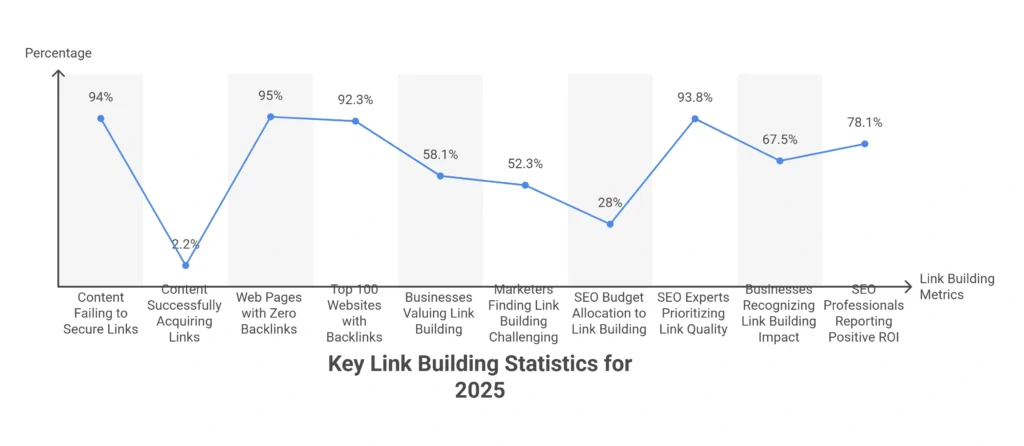
Google uses over 200 factors to rank websites, and links consistently stand out as one of the most prominent.
Despite this, a staggering 95% of all pages on the internet have zero backlinks, and 94% of online content fails to secure any external links. This highlights a massive opportunity for those who invest strategically in link building.
Key Link Building Statistics: Top Picks (2025)
| Statistic | Details |
| 94% of online content | Fails to secure any external links, with only 2.2% successfully acquiring them. |
| 95% of all internet pages | Have zero backlinks. |
| Digital PR | Is the most popular link building method, used by 67.3% of marketers. |
| 86% of marketing professionals | Use AI SEO tools; backlink automation is a top 3 AI tool choice. |
| 58.1% of businesses | Consider link building a key factor in improving SERP rankings. |
| Top-ranking Google pages | Have 3.8 times more backlinks than pages ranked 2nd to 10th. |
| 52.3% of digital marketers | Regard link building as the most challenging aspect of SEO. |
| 28% of marketing budgets | Go towards link building or purchasing quality backlinks. |
| 93.8% of SEO experts | Emphasize the importance of acquiring quality links. |
Emerging Trends and Strategies in 2025
The world of link building is dynamic, constantly adapting to Google’s algorithm updates and technological advancements like AI. Staying informed about the latest trends helps you leverage new opportunities and refine your approach.
Link Building is a Top Priority: SEO experts now consider link building the 3rd most important SEO ranking factor, right after content and keywords. This underscores its continued relevance in driving search performance.
Experience Matters: Experienced link builders consistently outperform beginners. Those with over five years of experience generate an average of 25 links per month, compared to just 7 links for beginners. This highlights the value of seasoned professionals in securing high-quality backlinks.
| Experience Level | Link Acquisition Per Month |
| Less than 1 year | 7 links |
| Between 1 and 2 years | 13 links |
| Between 2 and 5 years | 15 links |
| Over 5 years | 25 links |
Time to See Results: Link building efforts typically take about 3.1 months to show noticeable results. A survey reveals that most participants (46.6%) observe the impact of backlinks on search rankings within 1 to 3 months, with another 35.2% seeing results between 3 and 6 months. Patience and consistent effort are key.
| Time to Impact Search Rankings | Percentage of Marketers |
| Less Than 1 month | 7.5% |
| 1 to 3 months | 46.6% |
| 3 to 6 months | 35.2% |
| 6 to 12 months | 7.3% |
| Over 12 months | 3.3% |
Website Backlink Profiles: A significant 55.24% of websites lack any backlinks entirely, and 29.79% have fewer than three backlinks. This data points to a wide gap in link building adoption across the internet.
The Value of Nofollow Links: Around 54% of marketers consider nofollow links valuable. While they may not directly pass “link juice,” they contribute to a natural and diverse backlink profile, enhancing trust and brand visibility.
Digital PR on the Rise: Agencies and in-house SEO teams are over three times more likely to use digital PR than independent website owners. Digital PR, though more expensive, consistently delivers higher-quality backlinks.
| Background | PR Linkbuilding Popularity |
| Website Owners | 6.02% |
| Freelancers | 13.59% |
| In-House SEO | 23.78% |
| Agencies | 31.95% |
LinkedIn for Outreach: LinkedIn is emerging as the most effective platform for link building outreach, with 17.3% of SEOs using it in 2025. This shows the growing importance of professional networking in securing links.
Source: Search Logistics, Statista
How Many Backlinks Do You Need to Rank in 2025?
While there’s no magic number, statistics offer a clear indication of the impact backlinks have on rankings and traffic:
- Websites with 30 to 35 backlinks generate over 10,500 visits per month.
- An impressive 92.3% of the top 100 ranking websites have at least one backlink.
- Higher-ranking posts have more referring domains on average, clearly showing a correlation with Google rankings.
AI’s Impact on Link Building
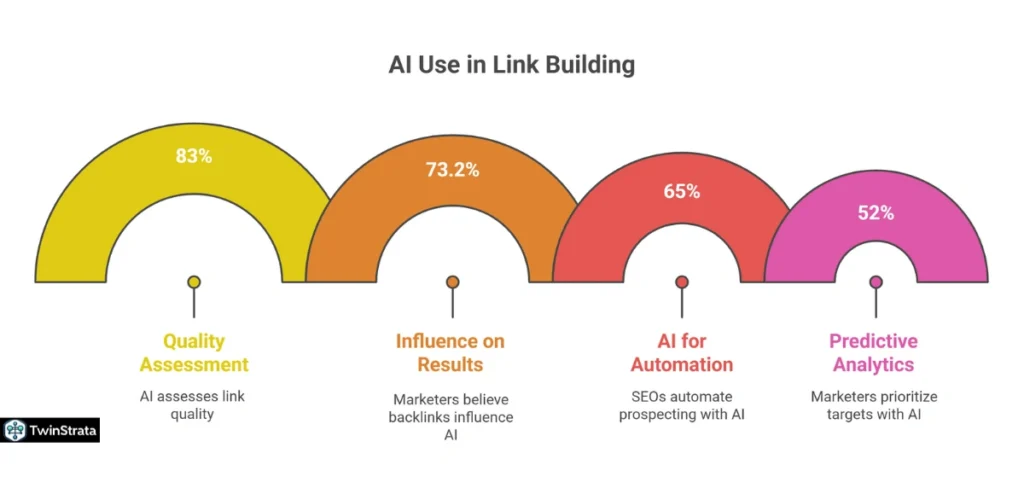
Artificial intelligence is rapidly transforming the SEO industry, and link building is no exception. Marketers are increasingly leveraging AI to streamline processes and gain a competitive edge.
- Influence on AI Search Results: A significant 73.2% of marketers believe backlinks influence the chance of appearing in AI search results (like ChatGPT and other LLMs).
- AI for Automation: 65% of SEOs use AI tools for automated prospecting and personalization in outreach.
- Quality Assessment: 83% of link building platforms use AI for advanced link quality assessment, effectively reducing the risk of toxic and spammy backlinks.
- Predictive Analytics: 52% of digital marketers utilize AI-based predictive analytics to prioritize link targets with the greatest SEO impact.
- AI Detection by Search Engines: Over 70% of major search engines now use AI technology to detect, devalue, or penalize large-scale, low-quality, and AI-generated backlinks, emphasizing the need for ethical AI use.
The Effectiveness of Link Building
Investing in link building yields significant returns when executed correctly.
- Limited Value of Paid Links: Paying for backlinks results in only a small increase of about 2 links per month, highlighting the limited value of paid strategies compared to organic, high-quality acquisitions.
- Long-Form Content Rules: Longer content, typically over 3,000 words, earns significantly more backlinks—about 3.5 times more—than shorter articles. This emphasizes the value of comprehensive and authoritative content.
- Brand Authority: Over 85% of SEO experts believe link building plays a crucial role in establishing brand authority. High-quality backlinks build trust and credibility with both search engines and users.
- SERP Impact: Around 67.5% of businesses recognize that link building significantly impacts their Search Engine Results Page (SERP) rankings.
- Positive ROI: Over 78.1% of SEO professionals report a positive return on investment (ROI) from their link building efforts.
- Difficulty for Large Companies: 41% of large companies find link building to be the most difficult aspect of SEO, indicating the complexity and resource intensity of managing extensive link building campaigns.
Quality Over Quantity: The Golden Rule
The overwhelming consensus among SEO professionals is that link quality far surpasses link quantity in importance.
- Quality First: Nearly 94% of link builders emphasize that link quality outweighs link quantity. Acquiring high-quality, authoritative backlinks is crucial for improving search rankings and driving valuable traffic.
- Experienced Builders Deliver Quality: Experienced link builders generate 3.57 times more links compared to beginners, and these often come from higher-quality sources due to their expertise and established networks.
Impact of Link Building on Search Rankings
The direct correlation between backlinks and search engine rankings is undeniable.
- Top 100 Websites: Approximately 92.3% of the top 100 ranking websites have at least one backlink, proving their crucial role in achieving higher rankings.
- Significant Impact: 58.1% of SEOs recognize that backlinks have a significant impact on search engine rankings, boosting website visibility and authority.
- Budget Allocation: Approximately 28% of SEO budgets are allocated to link building activities, reflecting its importance in driving organic traffic.
- Click-Through Rate: The #1 result on Google captures over 27.6% of all clicks, emphasizing the immense value of achieving top positions through effective SEO, including link building.
Popular Link-Building Strategies in 2025
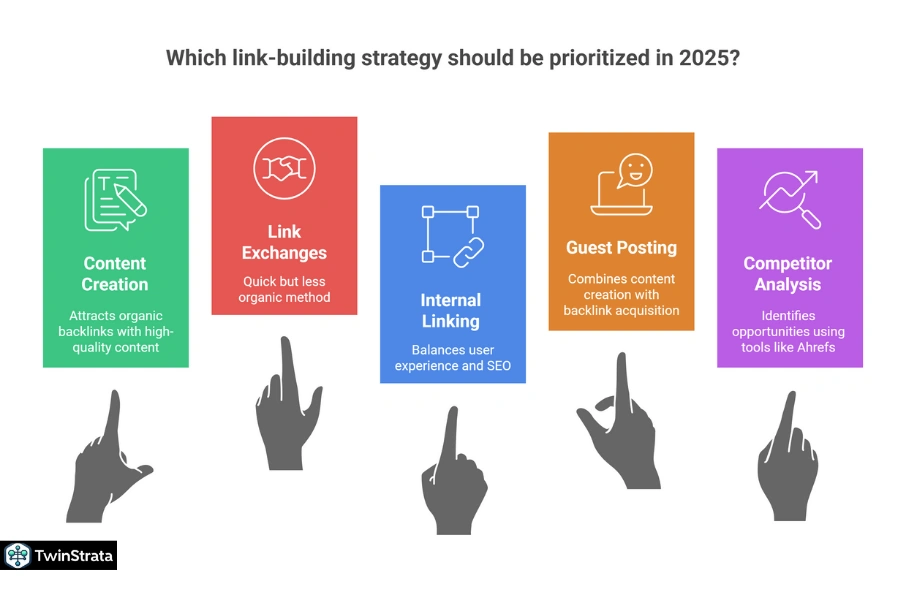
Marketers employ a variety of tactics to acquire backlinks. Understanding the most popular ones helps you prioritize your efforts.
- Content Creation: For 90% of marketers, content creation is the primary strategy for generating backlinks. Valuable, high-quality content naturally attracts links from other websites.
- Link Exchanges: Around 74.3% of contributors choose to pay for link exchanges, and 51.6% of link builders incorporate link exchanges into their strategy. While a quick win, this method is often less organic.
- Internal Linking: While 36% of SEO specialists prefer using four to five internal links in a blog post, a larger group of 51% opts for just two to three links, striking a balance between user experience and SEO.
- Tool Preference: Ahrefs is favored by 55.5% of link builders, making it the most popular tool for backlink analysis.
- Guest Posting: Guest posting remains a widely used strategy, favored by 64.9% of marketers. This involves creating valuable content for other websites in exchange for backlinks. Interestingly, 71.3% of link builders who pay for links frequently use guest posting.
- Competitor Analysis: 54% of businesses generate links through competitor analysis and link targeting, using tools like Ahrefs and Semrush to identify opportunities.
Most Popular Link-Building Tactics (2025)
| Link Building Tactics | Share of Marketers That Prefer Them |
| Guest Posting | 64.9% |
| Link Exchanges | 51.6% |
| Creating Content | 50% |
| HARO (Help A Reporter Out) | 46.3% |
| Buying Domains | 19.9% |
| PR Campaigns | 17.7% |
AI-Powered Link Building: The Next Frontier
AI is not just a trend; it’s becoming an integral part of link building.
- Growing Adoption: 44.2% of respondents already use AI-powered tools to enhance their link building strategies, and 47.33% plan to incorporate them in the next year.
- Efficiency Boost: HubSpot, by integrating AI-driven content analysis and link building tools, achieved a remarkable 300% increase in link building efficiency.
Role of Social Media in Link Building
Social media plays a significant, though often indirect, role in link building.
- Integration: Over 61% of digital marketers integrate social media into their link building strategies, leveraging platforms like Facebook, Twitter, and LinkedIn to share content and build relationships.
- Increased Backlinks: Link builders who use social media for outreach get 22% more backlinks each month, with 61.7% including it in their efforts.
- Platform Usage: 23.5% of link builders use Facebook and 17.3% use LinkedIn for outreach and finding contact information.
Link Building Costs Statistics
Understanding the financial investment required for effective link building is crucial for budgeting.
- Average Paid Link Cost: The average cost of a paid link is $83, covering only the placement fee. This cost excludes outreach or content creation expenses, and prices are rising due to inflation and demand.
- Experienced Builders are Cost-Effective: Experienced link builders provide links at a 41% lower cost per link than less experienced peers. Their higher productivity means more links at a reduced overall cost.
- Typical Monthly Budgets: 38.4% of businesses allocate $1,000 to $5,000 monthly for link building, making it the most common budget range. Only about 7.1% allocate over $15,000 monthly.
- Guest Post Costs: On average, a quality guest post costs $609, while a link insertion costs $141.
- Future Cost Increases: 40% of businesses believe the cost of link building will increase in the future, with 81% believing link building costs will rise over the next 2-3 years.
- Digital PR Budget: 66.5% of link builders doing digital PR operate with budgets below $10,000 per month.
Case Studies: Successful Link-Building Campaigns
Real-world examples demonstrate the power of strategic link building.
Case Study 1: The Skyscraper Technique by Backlinko
Brian Dean’s Skyscraper Technique involves identifying popular content, creating a superior version, and then reaching out to those who linked to the original. Backlinko’s application of this technique led to a 110% increase in organic traffic within just 14 days, securing 17 high-quality backlinks from 160 cold emails (an 11% success rate). This showcases the importance of quality over quantity. However, recent insights suggest that simply relying on traditional outreach for this technique may not be as effective today, with a potential need to pay for placements.
Case Study 2: Ahrefs Leveraged a ‘Stats’ Page to Build Backlinks and Achieve a #1 Ranking
Ahrefs used a tailored Skyscraper Technique for statistics pages, knowing they attract many backlinks but are often outdated. Their process involved:
- Topic Selection: Identifying high-demand topics.
- Prospect Identification & Refinement: Locating and prioritizing potential websites for links.
- Content Creation: Developing a robust, meticulously updated statistics page.
- Outreach: Gathering contacts, vetting prospects, and sending personalized emails.
The campaign sent 515 emails, resulting in 27 backlinks from contacted websites and 5 additional organic links, totaling 36 editorial links from 32 unique websites. The backlinks were of high quality, with 9 referring domains having a DR of 70 or higher, and many coming from websites with significant monthly search traffic. This strategic approach, focusing on quality content and targeted outreach, proved powerful for gaining high-quality backlinks and boosting search rankings.
Future of Link Building: What’s Next in 2025 and Beyond?
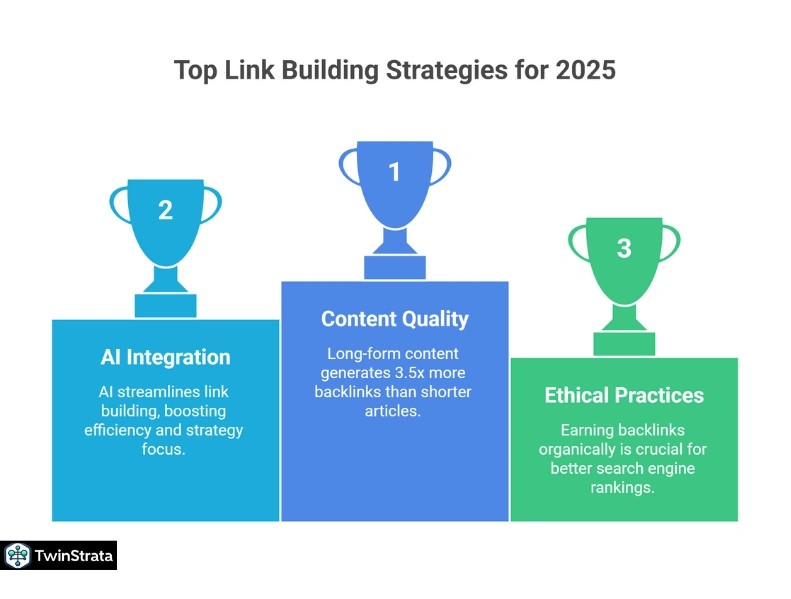
Link building remains essential, but its focus shifts towards quality, innovation, and ethical practices. To stay competitive, businesses must prioritize valuable content, leverage AI, and foster authentic partnerships.
- Content Quality as a Cornerstone: Long-form content (over 3,000 words) generates approximately 3.5 times more backlinks than shorter articles, emphasizing comprehensive, valuable content.
- AI Integration in Link Building: AI tools will streamline opportunity identification, content analysis, and outreach, boosting efficiency and allowing marketers to focus on strategy. 68% believe link building will be more important in the next two years due to AI, and 62% are prioritizing obtaining citations in AI-generated results.
- Influencer Collaborations: Partnering with industry influencers with authoritative websites will drive high-quality backlinks and amplify content visibility.
- Ethical Link Building Practices: The shift away from paid links highlights the importance of earning backlinks organically. Search engines reward relevance and authenticity with better rankings.
- E-E-A-T (Expertise, Experience, Authority, Trust) Focus: Google’s emphasis on E-E-A-T continues to grow. Content must demonstrate expertise and authority while building user trust, requiring factual, well-researched, and user-centric content.
- Established Agencies Excel: Agencies with over five years of experience are most successful, showcasing the importance of expertise and long-term commitment.
Link Building Management and Challenges
Managing link building effectively requires a structured approach and an understanding of common hurdles.
- In-House Management: 61% of organizations manage their link building entirely in-house, with almost a third employing a mix of agencies/freelancers and in-house teams.
- Confidence in External Teams: Only 30% of teams working with external link builders are fully confident in the results.
- Skill Improvement: 66% aim to improve their ability to select the best backlink tactics, and 63% want to get better at reporting on impact and ROI.
- Measuring Impact is Hard: 30.6% say measuring impact is the most challenging part of digital PR link building, followed by ideation (29.5%). 71.7% agree digital PR is more challenging than 12 months ago.
- Leadership Support: 65% of organizations have leadership support for link building as a long-term strategy, even with challenges.
- Time to Show Value: 60% have just 3-6 months to show the value of their link building efforts, with 46.2% seeing measurable results from digital PR campaigns after 3-6 months.
- Success Rate: Only 1 in 3 (30%) believe their link building efforts are successful.
Measuring and Reporting Link Building Success
Effective measurement and reporting are crucial for demonstrating ROI.
- Evaluating Link Impact: 59% of link builders evaluate a link’s impact by examining increased organic visibility for the target page. Just 28% measure increased revenue from organic visits.
- Digital PR Effectiveness: 89.6% say digital PR is most effective for building backlinks, followed by brand awareness (83.2%), and then driving organic traffic and rankings (77.5%). Only about 25% say digital PR is effective for driving leads and increasing sales (18.5%).
- Unlinked Brand Mentions: 80.9% believe unlinked brand mentions affect organic search rankings.
- Link Quality Metrics: 91.3% measure link quality through third-party metrics like DR/DA and site relevancy (86.7%).
- Goal Alignment: 61% of link builders align their goals with KPIs, while 22% don’t align their goals with any framework.
- Report Clarity: Just over half (53%) of link builders believe their link building reports are easy to understand.
- Benchmarking: 25% of link builders measure their efforts against a benchmark or control group.
Budgeting for Link Building
The financial investment in link building is a key consideration for marketers.
- Budget Acquisition: 29% say getting a budget for link building is easy in 2025.
- Investment Drivers: Most organizations invest in link building to improve organic traffic (68%) and rankings (68%). Only half build links to increase sales/revenue (48%).
- Future Investment: Over half (56%) of link builders plan to invest more in link building in the next 12 months, with 61% planning to do so to improve rankings. Only 39% will decrease spending, mostly due to budget cuts, and just 9% due to AI.
- Industries with High Budgets: About 61% say the igaming/gambling industry requires the highest link building budgets, and link builders in the legal industry appear to spend the most.
Insights from Quora and Reddit
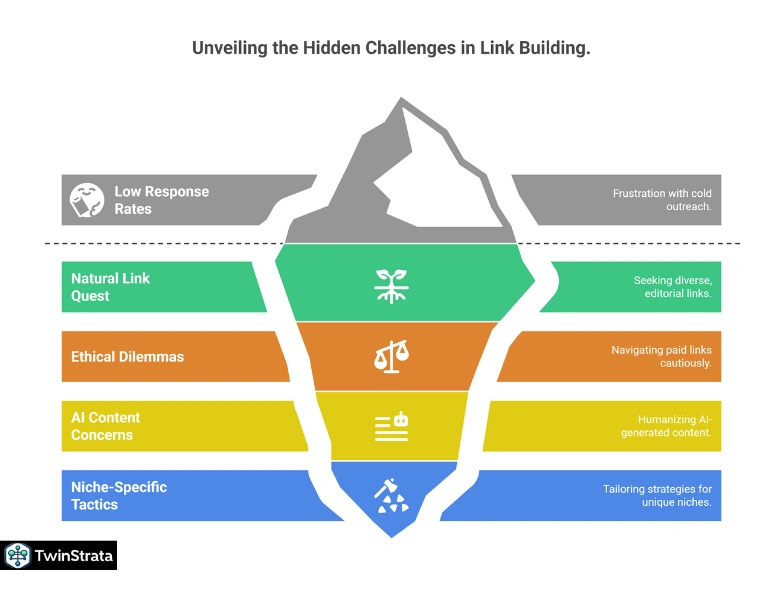
Building on the comprehensive link building statistics for 2025, a dive into platforms like Quora and Reddit reveals practical insights, common struggles, and nuanced perspectives from SEO practitioners and website owners. These discussions often highlight the “how-to” and “real-world” challenges that go beyond the raw numbers.
Here are some key insights from Quora and Reddit discussions:
- The Persistent Frustration with Outreach & Low Response Rates:
- Insight: While statistics show the popularity of guest posting and the effectiveness of experienced link builders, many users on Quora and Reddit express deep frustration with cold outreach. They frequently ask for advice on improving email subject lines, crafting personalized messages, and dealing with incredibly low response rates (often less than 5%). There’s a strong sentiment that getting someone to even open an email, let alone link, is a major hurdle. This underscores that while tools and strategies exist, the human element of persuasion and relationship-building remains intensely challenging.
- Connection to Stats: This directly relates to the stat that “experienced link builders consistently outperform beginners.” Experience often translates into more refined outreach techniques and better understanding of who to contact and how to approach them to overcome these low response rates.
- Beyond Guest Posts: The Quest for “Natural” & Diverse Link Profiles:
- Insight: While guest posting is popular, many users are actively discussing and seeking methods to acquire links that appear more “natural” and less transactional. This stems from a fear of Google penalties for overly obvious or low-quality guest post links. They frequently ask about:
- Resource Page Link Building: How to get featured on existing resource pages or “best of” lists.
- Broken Link Building: Finding broken links on authoritative sites and offering their content as a replacement.
- Infographics & Data Visualizations: Creating shareable visual content that naturally attracts links.
- Unlinked Brand Mentions: Actively monitoring for mentions of their brand and converting them into links, which aligns with the insight that brand mentions correlate with AI Overviews.
- Connection to Stats: This complements the statistic that “94% of online content fails to secure any external links” and “93.8% of SEO experts emphasize the importance of acquiring quality links.” Users are trying to move beyond sheer volume and focus on diverse, editorially-given links that genuinely add value.
- Insight: While guest posting is popular, many users are actively discussing and seeking methods to acquire links that appear more “natural” and less transactional. This stems from a fear of Google penalties for overly obvious or low-quality guest post links. They frequently ask about:
- The Ethical Minefield of Paid Links and Link Exchanges (and how to navigate it “safely”):
- Insight: Despite warnings from Google and the statistic that “paying for backlinks results in only a small increase of about 2 links per month,” discussions about buying links and link exchanges are rampant. Users often ask about “safe” ways to buy links, how to vet sellers, or if certain types of paid links (e.g., editorial insertions on aged sites) are less risky. There’s a clear tension between wanting quick results and fearing penalties. This indicates that while many understand the risks, the perceived ease and speed of paid links make them a tempting shortcut for some.
- Connection to Stats: This directly relates to “the average cost of a paid link is $83” and “74.3% of contributors choose to pay for link exchanges.” Quora and Reddit discussions expose the practical anxieties and workarounds people attempt within these practices, often pushing the boundaries of what’s considered “white-hat.”
- AI as a Content
- Insight: While the articles mention AI for automation and quality assessment, discussions on Quora and Reddit delve deeper into using AI for generating content specifically for link building (e.g., drafting guest posts, writing blog summaries for outreach). Users are excited about the efficiency gains but also express concerns about AI-generated content lacking a “human touch,” being flagged by Google, or simply not being good enough to earn a link. They seek advice on how to “humanize” AI output.
- Connection to Stats: This provides a practical layer to the statistic that “43% of link builders use AI for creating content, such as guest posts.” The community discussions reveal the operational challenges and quality control needed when implementing AI for content creation in link building.
- The Search for Niche-Specific Link Building Tactics:
- Insight: A common type of question seen on these platforms is “How do I build links in [x] niche?” (e.g., extremely local businesses, highly technical B2B, sensitive industries). Users acknowledge that general strategies don’t always apply, and they are looking for highly tailored advice, often sharing their unique constraints (e.g., “my industry doesn’t have many blogs to guest post on,” “competitors are using questionable tactics”).
- Connection to Stats: This adds a granular dimension to the statistics about “challenging industries to build links in” (e.g., Fashion/Beauty, Education, Health/Wellness). These discussions provide anecdotal evidence of why certain niches are difficult and what specific workarounds people are trying.
These Quora and Reddit insights collectively paint a picture of a link building landscape where the theoretical understanding of what works is often met with significant practical hurdles. The community actively seeks solutions for improving outreach, finding ethical alternatives to paid links, leveraging AI smartly, and adapting strategies to highly specific circumstances.
FAQs About Link Building Statistics
1. Why is link building still so important in 2025, even with the rise of AI?
Link building remains vital as Google still prioritizes backlinks for ranking, signaling trust and credibility. AI enhances spam detection but can’t replace high-quality, authoritative links.
2. How has AI changed the way marketers approach link building?
AI automates tasks like prospecting and outreach, increasing efficiency. However, search engines use AI to detect low-quality links, so ethical link building remains essential.
3. What are the most effective link building strategies for 2025?
Top strategies include digital PR, long-form content, and strategic guest posting. Quality links from authoritative sources are key, though costs for placements are rising.
4. How long does it take to see results from link building?
Link building typically shows results in 1 to 3 months, though full impact may take 3 to 6 months with consistent effort.
5. What challenges do marketers face in link building today?
Challenges include measuring ROI, acquiring high-quality backlinks, and adapting to changing search engine algorithms and rising costs.
Also Read:
- Marketing Automation Statistics
- Infographics Statistics
- AI Recruitment Statistics
- TikTok Statistics
- Video Marketing Statistics
Conclusion:
While AI tools offer incredible efficiencies, the human element in link building remains irreplaceable.
The ability to craft compelling content, build genuine relationships, and strategically analyze opportunities still requires human expertise.
The combination of advanced AI tools and experienced human strategists will likely define the most successful link building campaigns in 2025 and beyond.
